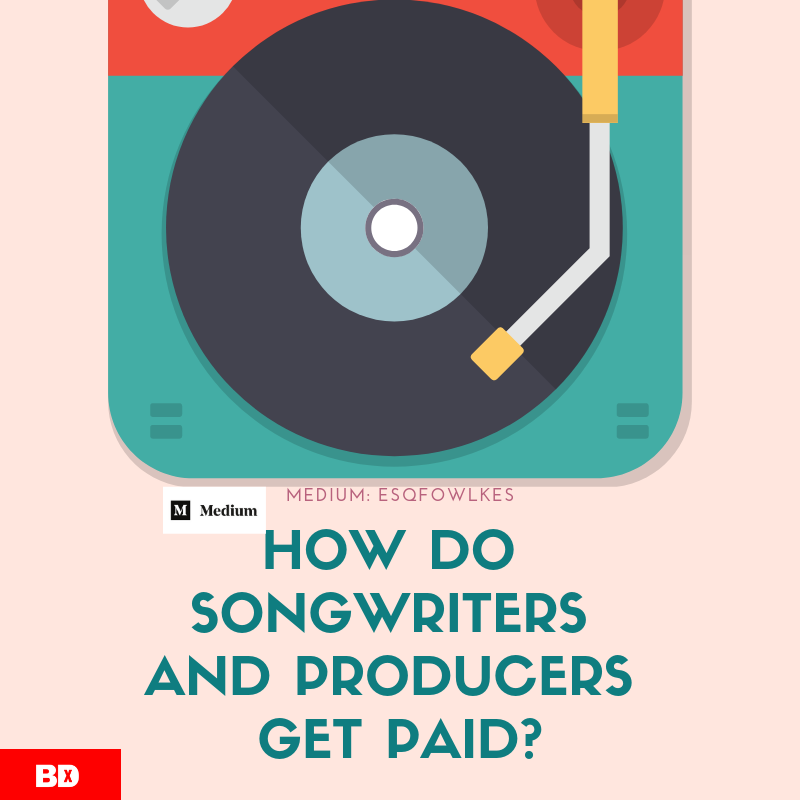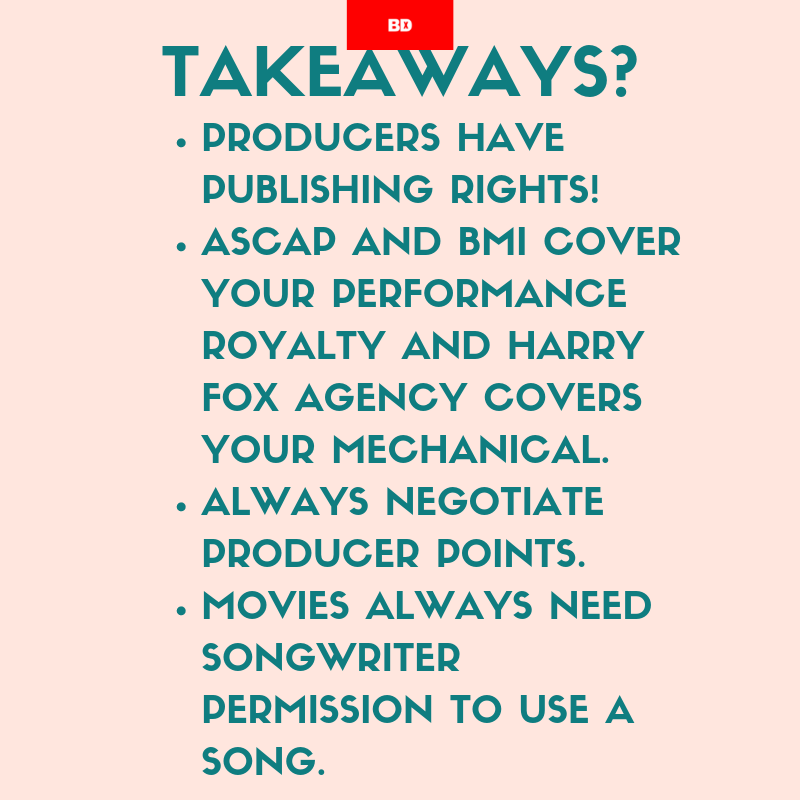
Producers and Songwriters respectively are some of the least appreciated but most deserving components in music. For many main acts, producers and songwriters are the engines that drive success. Songwriters and Producers like Starrah, Metro Boomin, Cardo, Murda Beatz, Nija, etc have become staples in music culture and fandom alike.
For songwriters and producers who have not received any or many major placements, understanding the publishing and payment structure for songwriters and producers in music can be confusing. Even if you have earned some major placements, producers and songwriters can easily get taken advantage of without a competent entertainment attorney and an understanding of the music business.
Producers
Let?s start by understanding the ways a producer is paid.
- Front End Fee (Advance)
Depending on who you are working with, you will receive a fee for the beat. This fee is usually outlined and discussed in the Producer Agreement that producers sign with artists and record labels. While a Producer should always want points (see below), depending on the size of the upfront fee and the nature of the artist using the record, a situation with no points and a large upfront fee could suffice. As your talent and reputation grow, so will this number. Also, understand that if you are exclusively selling your copyright in the music as opposed to licensing a beat, that will determine the size of the fee.
It should also be of note that the larger the label the more money they have to shell out. Thus if you are working with an independent artist you might be able to get more points on the record because they can’t pay for your song up front.
In addition, if you are getting points on a record, then your upfront fee (advance) will be subtracted against future royalties. Keep that in mind!
- Publishing Royalties
Generally, the composer and publisher split is 50?50 (this proportion is represented in percentages as 50%/50% in most of the publishing world) and 100%/100%, specific to BMI, but it is the same proportion.
In Hip Hop and R&B, publishing is generally split between the music and the lyrics. Thus, some Hip Hop and R&B music producers can get as high as half of a record?s publishing.
However, an alternative view is that a producer is not necessarily entitled to publishing royalties. If the producer simply made the beat and only the beat and didn?t contribute much in regards to the melody and lyrics then it is completely plausible that an inexperienced producer with a weak legal team will get shafted into believing or signing an agreement that forfeits publishing.
However, if a producer is in the studio making a song with the songwriters and artist then it is very likely the producer will be entitled to not only a share of the producers share of publishing but also the lyrics. Publishing can be a way for the producer to get fairly compensated for their contributions. Additionally, a big name producer will also likely seek Publishing because there name contributed to the success of the record.
A general rule of thumb, however, is that if you have produced a record and even if you only made the beat, you deserve a portion of the Publishing. The simple breakdown being you own half of the record?s publishing if you created the beat and the other half is distributed out to the songwriters.
There is no law that says a music producer is entitled to publishing, but it is standard practice. Producers get your Publishing!
- Production Points
An artist?s master recording royalty (which typically ranges from 12% to 18% at a major label) is the crux of why anyone signs a record deal. The recording of the song is what we refer to as the?masters?. It?s what the label invests all of their time and money in selling to the public thus it is an important way for an artist and producer to get paid. Usually, a producer makes 3% to 5% (20% to 25%) of the artists share of a master recording. This number could be a bit higher if the producer is influential and has a brand of their own.
Unlike the artist, the producer usually receives his royalty from the first record sold after recoupment of recording costs (usually an advance to the producer). This means that once gross income exceeds recording costs, the producer is paid for all records sales going forward? the artist is not until they recoup for all other costs.
If an artist is at an indie label or is represented by himself, producers will likely take a higher percentage on points because they are less likely to receive an upfront fee.
In order for the producer to receive a piece of the SoundExchange royalties, you?d need to include the allocation in your agreement and have the ARTIST sign a Letter of Direction, which you?ll submit to SoundExchange.*
- Beat Leasing
When a producer leases a beat to an artist, a producer is allowing an artist to use their beat while the producer maintains full ownership of the copyright in the beat while also giving the artist either an exclusive or (usually) non-exclusive license to use the beat, typically for a set period of time and/or a set number of exploitations (sales and streams). Beat leasing similar to car leasing usually exists because of a fiscal issue from the consumer side. An artist might not have the money to purchase the full rights in a beat but they want to use it for a project or for promotion. On the contrary, a producer wants income for their beats and this is a way for them to continue to add income while getting there work out there to the public. Producers usually do not forfeit the highest quality of their beat to an Artist under a beat leasing agreement. If someone, wants to use a beat exclusively, this is the way a Producer can make sure they are compensated and can renegotiate later if the song takes off.
Songwriters
- Synch Fee
A synchronization license is an agreement between a music user and the owner of a copyrighted composition (song), that grants permission to release the song in a video format (YouTube, DVDs, Blue-ray discs, Commercials, TV).
A songwriter receives a synch fee when his/her song is licensed for use to synchronize with video. This royalty is freely negotiated in the marketplace and is typically split 50% to the publishers (songwriters and producers) and 50% to the artist and record label, meaning there are two levels of clearance for a master recording in a movie. Thus, synchronization licenses are obtained from the songwriter or publisher. Permission from the record company (master use license) also needs to be obtained if a specific recorded version of a composition is used for a purpose.
For further clarity, if someone is only using the lyrics of a song, the songwriter or publisher is the only one who needs to be paid.
A synchronization license is required no matter how small a portion of the song you use. Additionally, if just one of the songwriters decides they don?t want to grant the license, the song can?t be used.
Example:
If T-Mobile wants to use Bryson Tiller?s song ?Don?t? for a TV advertising campaign, it has to get a sync license from the publisher(s) of the song and get a Master Recording License (Master Use License)for obtaining permission to use a particular sound recording of a song.
If T-Mobile wanted to get a different artist to record the song, they would not need the master use license, only a sync license.
Fees are generally in the form of one-time payments, although the arrangement can be a ?stepped? deal (e.g., one fee for motion picture use and an additional payment for video rights).
As you can imagine this can be extremely lucrative for songwriters (and producers).
Producers will collect a synch fee on both ends if they retain publishing and have points.*
- Public Performance Royalty
Public performances generate performance royalties for songwriters/producers, which are collected by the PROs (ASCAP, BMI, or SESAC). A songwriter receives a public performance royalty when their song is performed on terrestrial broadcast radio, in a live performance venue, or via online streaming services. Radio airplay (terrestrial broadcast radio) is considered a public performance. In the US, terrestrial broadcasters (AM or FM stations) do not pay performers or sound recording copyright owners; they only pay the songwriters and producers.
- Live Performance and Broadcast (radio/TV)
- Digital Performance (streaming, satellite radio)
- Public Performance such as in bars, clubs and restaurants of a certain size
Producers also need to register with a PRO to collect their publishing!
- Mechanical Royalty
Many songwriters make the major mistake of thinking that because they are members of BMI, ASCAP, or SESAC that they will be paid mechanical royalties. To get paid your mechanical royalties, you must be registered for a separate collection society that specifically works on mechanicals. In the US, this group is the Harry Fox Agency.
As you know streaming is the way most consume music. A songwriter/producer is owed a royalty (from the ?Reproduction? copyright) for every stream of his or her song on an interactive streaming service. Unless otherwise negotiated, the rates are still determined by statute. For interactive services, the Copyright Royalty Board (?CRB?) sets an ?All-In Royalty Pool? of 10.5% of music service revenue. Then performance royalties are deducted from the All-In Royalty Pool to come up with what is call the ?Payable Royalty Pool.
On January 28th, 2018, the United States Copyright Board (CRB) ruled that for the next five years (from 2018?2022) the per-stream royalty rate for mechanical royalties will increase incrementally from the current 10.5% of Gross revenue to 15.1% of Gross revenue. This simply means more money for songwriters and producers!
Producers also need to register with Harry Fox to collect their mechanical royalties from publishing.*



